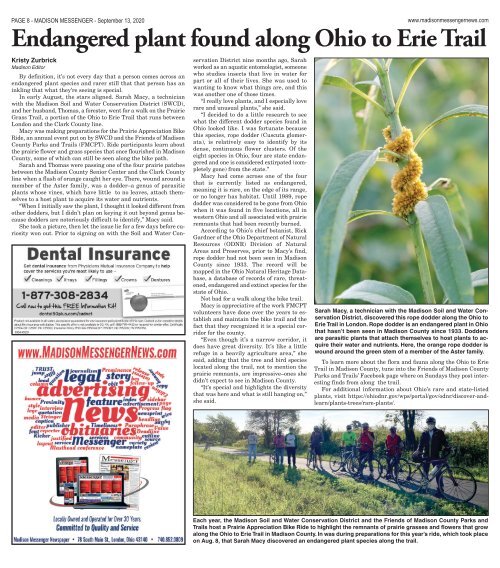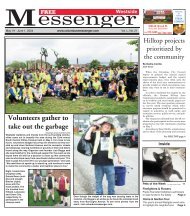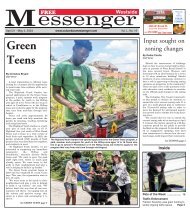Create successful ePaper yourself
Turn your PDF publications into a flip-book with our unique Google optimized e-Paper software.
PAGE 8 - MADISON MESSENGER - <strong>September</strong> 13, <strong>2020</strong><br />
www.madisonmessengernews.com<br />
Endangered plant found along Ohio to Erie Trail<br />
Kristy Zurbrick<br />
<strong>Madison</strong> Editor<br />
By definition, it’s not every day that a person comes across an<br />
endangered plant species and rarer still that that person has an<br />
inkling that what they’re seeing is special.<br />
In early August, the stars aligned. Sarah Macy, a technician<br />
with the <strong>Madison</strong> Soil and Water Conservation District (SWCD),<br />
and her husband, Thomas, a forester, went for a walk on the Prairie<br />
Grass Trail, a portion of the Ohio to Erie Trail that runs between<br />
London and the Clark County line.<br />
Macy was making preparations for the Prairie Appreciation Bike<br />
Ride, an annual event put on by SWCD and the Friends of <strong>Madison</strong><br />
County Parks and Trails (FMCPT). Ride participants learn about<br />
the prairie flower and grass species that once flourished in <strong>Madison</strong><br />
County, some of which can still be seen along the bike path.<br />
Sarah and Thomas were passing one of the four prairie patches<br />
between the <strong>Madison</strong> County Senior Center and the Clark County<br />
line when a flash of orange caught her eye. There, wound around a<br />
member of the Aster family, was a dodder—a genus of parasitic<br />
plants whose vines, which have little to no leaves, attach themselves<br />
to a host plant to acquire its water and nutrients.<br />
“When I initially saw the plant, I thought it looked different from<br />
other dodders, but I didn’t plan on keying it out beyond genus because<br />
dodders are notoriously difficult to identify,” Macy said.<br />
She took a picture, then let the issue lie for a few days before curiosity<br />
won out. Prior to signing on with the Soil and Water Conservation<br />
District nine months ago, Sarah<br />
worked as an aquatic entomologist, someone<br />
who studies insects that live in water for<br />
part or all of their lives. She was used to<br />
wanting to know what things are, and this<br />
was another one of those times.<br />
“I really love plants, and I especially love<br />
rare and unusual plants,” she said.<br />
“I decided to do a little research to see<br />
what the different dodder species found in<br />
Ohio looked like. I was fortunate because<br />
this species, rope dodder (Cuscuta glomerata),<br />
is relatively easy to identify by its<br />
dense, continuous flower clusters. Of the<br />
eight species in Ohio, four are state endangered<br />
and one is considered extirpated (completely<br />
gone) from the state.”<br />
Macy had come across one of the four<br />
that is currently listed as endangered,<br />
meaning it is rare, on the edge of its range,<br />
or no longer has habitat. Until 1989, rope<br />
dodder was considered to be gone from Ohio<br />
when it was found in five locations, all in<br />
western Ohio and all associated with prairie<br />
remnants that had been recently burned.<br />
According to Ohio’s chief botanist, Rick<br />
Gardner of the Ohio Department of Natural<br />
Resources (ODNR) Division of Natural<br />
Areas and Preserves, prior to Macy’s find,<br />
rope dodder had not been seen in <strong>Madison</strong><br />
County since 1933. The record will be<br />
mapped in the Ohio Natural Heritage Database,<br />
a database of records of rare, threatened,<br />
endangered and extinct species for the<br />
state of Ohio.<br />
Not bad for a walk along the bike trail.<br />
Macy is appreciative of the work FMCPT<br />
volunteers have done over the years to establish<br />
and maintain the bike trail and the<br />
fact that they recognized it is a special corridor<br />
for the county.<br />
“Even though it’s a narrow corridor, it<br />
does have great diversity. It’s like a little<br />
refuge in a heavily agriculture area,” she<br />
said, adding that the tree and bird species<br />
located along the trail, not to mention the<br />
prairie remnants, are impressive—ones she<br />
didn’t expect to see in <strong>Madison</strong> County.<br />
“It’s special and highlights the diversity<br />
that was here and what is still hanging on,”<br />
she said.<br />
Sarah Macy, a technician with the <strong>Madison</strong> Soil and Water Conservation<br />
District, discovered this rope dodder along the Ohio to<br />
Erie Trail in London. Rope dodder is an endangered plant in Ohio<br />
that hasn’t been seen in <strong>Madison</strong> County since 1933. Dodders<br />
are parasitic plants that attach themselves to host plants to acquire<br />
their water and nutrients. Here, the orange rope dodder is<br />
wound around the green stem of a member of the Aster family.<br />
To learn more about the flora and fauna along the Ohio to Erie<br />
Trail in <strong>Madison</strong> County, tune into the Friends of <strong>Madison</strong> County<br />
Parks and Trails’ Facebook page where on Sundays they post interesting<br />
finds from along the trail.<br />
For additional information about Ohio’s rare and state-listed<br />
plants, visit https://ohiodnr.gov/wps/portal/gov/odnr/discover-andlearn/plants-trees/rare-plants/.<br />
Each year, the <strong>Madison</strong> Soil and Water Conservation District and the Friends of <strong>Madison</strong> County Parks and<br />
Trails host a Prairie Appreciation Bike Ride to highlight the remnants of prairie grasses and flowers that grow<br />
along the Ohio to Erie Trail in <strong>Madison</strong> County. In was during preparations for this year’s ride, which took place<br />
on Aug. 8, that Sarah Macy discovered an endangered plant species along the trail.


















